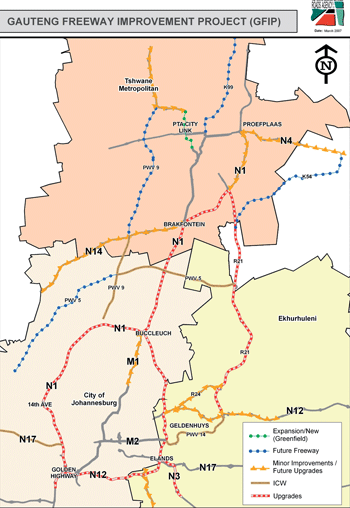
People who live in the Gauteng area are aware that the growth in the economy, subsequent improvement in living conditions and access to private vehicles, has caused a situation where the road system in the area around Johannesburg, Pretoria and Ekurhuleni is taking strain, particularly around peak hours.
Although South Africa is widely recognised as having the second best road system in the world, the traffic and congestion caused by the increase in vehicles in this particular region leads to a decline in the quality of life and wastage of valuable resources. The N1 between Pretoria and Johannesburg carries more than 180 000 vehicles daily.
The congestion on the main routes has substantial adverse effects on the amount of time that people can spend with their families, their productivity in the workplace, levels of frustration and unhappiness of drivers, and also has an effect on the environment through excessive emissions.
The South African National Roads Agency Limited (SANRAL) is responsible for the development, maintenance and operation of 16 150 kilometres of roads which are considered to be of national importance, of which 2400 kilometres are tolled.
SANRAL has developed a project, together with its partners, the metro authorities in Tshwane, Johannesburg, Ekurhuleni and the Province of Gauteng, to upgrade and/or construct approximately 500 kilometres of road around the three metros which will provide a safe and reliable strategic network and optimise the movement of freight and road-based public transport.

This will be done through the creation of an interconnected network of inner and outer ring-roads, and will also provide a direct link to the historically neglected areas of the south western townships of Johannesburg.
The plans include inter-modal transport hubs to surface and rail-based public transport facilities. The proposed system will also promote concepts such as travel demand management through the provision of dedicated, high occupancy vehicle (HOV) lanes and associated infrastructure.
The project is planned to be implemented in phases, starting with the environmental impact assessment, expanding the carrying capacity of the roads, and other improvements including the further roll-out of the intelligent transport system currently operating on Ben Schoeman.
The environmental impact assessment, which includes a public participation process, has begun on various sections of the road network including sections of the N14 and R21. The social and economic impact assessments are also underway.
The project will be financed through the ‘user pays’ principle, which is an equitable way of paying for a service that is used. As an extension to the ITS, new technologies will be implemented which will allow for the free flow of traffic. The system will use a system of electronic toll collection that will allow the motorist to travel unhindered.
Due to the number of financial demands on central government for housing, education, health, social grants and other obligations in a developing economy, central government relies on SANRAL to find funding for infrastructure development, and a tolling system will enable the identification of investors to raise the money, without resorting to the national fiscus for the large sums required for such a sophisticated system.
Q&A with SANRAL
Q: What is SANRAL’s role in the safety and security of road users?
A: The role of SANRAL (South African National Roads Agency Limited) is to provide a safe and forgiving road infrastructure. We do, however, have a road safety component as part of our community development section, and this deals with education in areas affected by our national road system, and in areas where we assist communities with improved infrastructure, eg in rural areas we build bridges and improve access to assist with economic upliftment. Primarily, SANRAL’s role in safety and security is to address infrastructure issues.
Q: What are the threats faces by those users?
A: Threats are unsafe driving behaviour by road users, as well as security in terms of highjackers or criminals of some kind or another.
?Q: What has been done to overcome/prevent those threats?
A: Enforcement is carried out by provincial and local authority traffic officers and the SAPS (South African Police Services). SANRAL has no enforcement arm at all. Enforcement activities are coordinated by the RTMC (Road Traffic Management Corporation) to ensure that there is a national list of priorities. The priority at the moment is to increase seat belt wearing. SANRAL also has introduced an ITS (intelligent transport system) on the Ben Schoeman highway, which is to be rolled out throughout Gauteng shortly. This system has cameras that monitor the roads for incidents that may affect traffic, but can also be used to identify problems in respect to safety and security.
Q: Are the security systems all in place and there to stay for a while, or is the total solution a phased procedure?
A: The ITS is definitely here to stay and will be increased for use throughout Gautent. Other municipalities such as Cape Town and Durban are also looking at putting in a similar system. Business Against Crime also has a forum with the SAPS to make an effort to reduce crime (road and other) on the roads.
Q: How, and by whom, are security issues analysed and how are appropriate solutions decided upon and selected?
A: Road crime is measureable in the form of crash statistics, and the SAPS keep other statistics in respect to usual crime. RTMC collect the road safety statistics. They are available on www.arrivealive.co.za, or from the RTMC directly. (+27 (0)12 665 6000)
Q: Are there any different or special plans in place leading up to 2010?
A: Much of the work being done in respect of the Gauteng Freeway Improvement Scheme will be done in time for 2010 as we have, as a country, undertaken to provide a safe infrastructure for the FIFA World Cup. Obviously particular emphasis will be given to the roads near the identified stadia.
For more information contact SANRAL, +27 (0)12 426 6226, [email protected], www.nra.co.za

© Technews Publishing (Pty) Ltd. | All Rights Reserved.